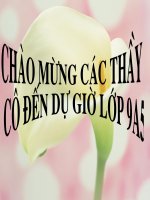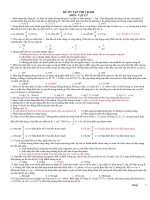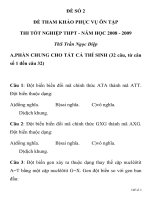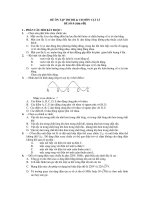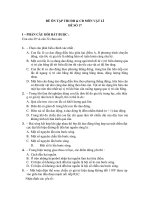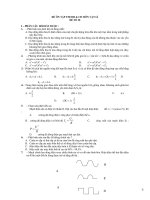de on tap thi thpt qg mon TA
Bạn đang xem bản rút gọn của tài liệu. Xem và tải ngay bản đầy đủ của tài liệu tại đây (163.41 KB, 14 trang )
SỞ GD- ĐT BẠC LIÊU
TRƯỜNG THPT ĐỊNH THÀNH
(ĐỀ ĐỀ XUẤT)
ĐỀ ÔN THI THPT QUỐC GIA NĂM 2017
MÔN THI: TIẾNG ANH
Thời gian: 70 phút
Read the following passage and mark the letter A, B, C or D on your answer to
indicate the correct word or phrase that best fits each of the numbered blanks from
01 to 10.
Early writing and Alphabets
When people first began to write, they did not use an alphabet. Instead, they drew small
pictures to (01) ______ the objects they were writing about. This was very slow because
there was a different picture for (02) ______ word.
The Ancient Egyptians had a (03) ______ of picture writing that was (04) ______
hieroglyphics. The meaning of this writing was forgotten for a very long time but in 1799
some scientists (05) ______ a stone near Alexandria, in Egypt. The stone had been there
for (06) ______ a thousand years. It had both Greek and hieroglyphics on it and
researchers were finally able to understand what the hieroglyphics meant.
An alphabet is quite different (07) ______ picture writing. It (08) ______ of letters or
symbols that represent a sound and each sound is just part of one word. The Phoenicians,
(09) ______ lived about 3,000 years ago, developed the modern alphabets. It was later
improved by the Roman’s and this alphabet is now used (10) ______ throughout the
world.
Question 1: A. notice
B. show
C. appear
Question 2: A. some
B. all
C. every
D. any
Question 3: A. practice
B. manner
C. plan
D. system
Question 4: A. known
B. called
C. described
Question 5: A. discovered
B. realized
D. mark
D. referred
C. delivered
D. invented
Question 6: A. quite
B. more
C. over
D. already
Question 7: A. at
B. from
C. before
D. between
Question 8: A. consists
B. includes
C. contains
Question 9: A. which
B. whose
C. what
Question 10: A. broadly
B. widely
C. deeply
D. involves
D. who
D. hugely
Mark the letter A, B, C, or D on your answer sheet to indicate the word that differs
1
from the other three in the position of primary stress in each of the following
questions.
Question 11: A. disappearance
B. conversation
Question 12: A. eradicate
C. contaminate D. government
B. technology
C. incredible D.
pessimist
Question 13: A. conical
B. sacrifice
C. approval
D. counterpart
Mark the letter A, B, C, or D on your answer sheet to indicate the correct answer to
each of the following questions.
Question 14: One difference between mathematics and language is that mathematics is
precise _________.
A. language is not
B. while language is not
C. but language not
D. while is not language
Question 15: Seldom _________ far enough north to disturb South Pacific shipping
lanes.
A. Antarctic icebergs will move
B. will Antarctic icebergs move
C. will move Antarctic icebergs
D. move Antarctic icebergs will
Question 16: _________ the United States consists of many different immigrant groups,
many sociologists believe there is a distinct national character.
A. Even though
B. Despite
C. Whether
D. In spite of
Question 17: The article analyzes the impact of the tax base _______ real estate prices
and sales.
A. in
B. on
C. at
D. with
Question 18: She _______ to the station every day but then she suddenly decided to
walk instead.
A. used to
B. was used to
C. had used to
D. didn’t used to
Question 19: If I ______ following that other car too closely, I would have been able to
stop in the time instead of running into it.
A. wasn’t
B. weren’t
C. hadn’t been
D. would have been
Question 20: Our village had _______ money available for education that the schools
had to close.
A. so little
B. such little
C. so much
D. such much
2
Question 21: Fort Niagara was built by the French in 1762 on land ______ the Seneca
Indians.
A. they buy from
B. bought from
C. buying from
D. was
bought from
Question 22: Experts ______ feel that they are related to the deep wishes and fears of the
dreamer.
A. study dreams
B. who dream study
C. who study dreams
D. whose dreams study
Question 23: Art critics and historians alike claim that Van Gogh’s art ______ from that
of his contemporaries.
A. is a considerable difference
B. is considerably different
C. the difference is considerable
D. is considerably and differently
Question 24: Most countries spend a large portion of their budgets _______ for their
citizens.
A. education provided
B. provide education
C. to educational provides
D. providing education
Question 25: Renoir is one of the most popular French impressionist painters. His
paintings _______ masterpieces all over the world.
A. have considered
B. are considering C. considered
D. are considered
Question 26: Sheila Hammond, who was only twenty-three when she was elected as a
Member of Parliament, said she owed her success all to the way she had been ________
by her mother, Margaret.
A. brought up
B. taken after
C. looked for
D. caught for
Question 27: Ken and Tom are high-school students. They meet each other at a gallery
but Ken is in a hurry.
Ken: “I’ve got to go, Tom. So long”
Tom: “So long, Ken. And _______.”
A. be careful
B. take care
C. don’t hurry D. don’t take it
seriously
Question 28: We need _______ actions and interventions of the local authorities to
prevent national parks from being destroyed by pollution.
3
A. excitedly
B. approximately
C. threateningly
D.
timely
Question 29: Mike and Lane are neighbors. They are talking about Lane’s party.
Mike: “Thank you for a lovely evening”
Lane: “________”
A. It depends on you.
B. Thank you very much indeed.
C. Yeah. I’m really looking forward to it.
D. You are welcome.
Question 30: We all seem to have a different opinion, so let’s Joey decide, ______?
A. will we
B. do we
C. shall we
D. are we
Question 31: No one can decline the _______ of the Alaskan wildness.
A. breath-taking scene
B. breath-taken view
C. breath-to-take scene
D. breath-taking view
Question 32: A quick look would reveal that France has twice ____________ computers.
A. more television than
B. as many television as
C. as many as television
D. many as television as
Mark the letter A, B, C, or D on your answer sheet to indicate the word whose
underlined part differs from the other three in pronunciation in each of the
following questions.
Question 33: A. academic
B. grade
C. behave
D. examination
Question 34: A. humor
B. honest
C. hotel
D. hurry
Mark the letter A, B, C, or D on your answer sheet to indicate the word(s)
CLOSEST in meaning to the underlined word(s) in each of the following questions.
Question 35: The United Nations Educational, Scientific and Cultural Organization
(UNESCO), was established in 1946.
A. set up
B. found out
C. run through
D. put away
Question 36: Paris is the ideal place to learn French; it’s a beautiful and hospitable city
with Institutions for high quality linguistic teaching.
A. friendly
B. natural
C. affectionate
D. noticeable
Question 37: Species that have already lost habitat because of deforestation are given
higher priority in the plan because of their greater risk of extinction
A. a thing that you do often and almost without thinking
4
B. the place where a particular type of animal or plan is normally found
C. a subject that student don’t understand
D. a theme that everyone likes to discuss
Mark the letter A, B, C, or D on your answer sheet to indicate the underlined part
that needs correction in each of the following questions.
Question 38: The scholarship that Wilson received to study history at Cambridge
presented an unique opportunity.
A. that
B. history
C. at Cambridge
D. an
Question 39: Amelia Earhart, the first woman to fly solo across the Atlantic, disappeared
on June 1937 while attempting to fly around the world.
A. to fly
B. the Atlantic
C. on
D. attempting
Question 40: The closer it gets to December 21, the first day of winter, the short the days
become.
A. gets to
B. first day
C. short
D. become.
Question 41: Alice in Wonderland, first published in 1865, has since being translated
into thirty languages.
A. published
B. has
C. being
D. languages
Question 42: Modern art is on display at the Guggenheim Museum, a building with an
unusually design.
A. Modern art
B. display
C. a building
D. unusually
Read the following passage and mark the letter A, B, C, or D on your answer sheet
to indicate the correct answer to each of the questions from 43 to 52.
A rather surprising geographical feature of Antarctica is that a huge freshwater, one of
the world’s largest and deepest, lies hidden there under four kilometers of ice. Now
known as Lake Vostok, this huge body of water is located under the ice block that
comprises Antarctica. The lake is able to exist in its unfrozen state beneath this block of
ice because its waters are warned by geothermal heat from the earth’s core. This thick
glacier above Lake Vostok actually insulates it from frigid temperatures (the lowest ever
recorded on Earth) on the surface.
The lake was first discovered in the 1970s while a research team was conducting an
aerial survey of the area. Radio waves from the survey equipment penetrated the ice and
5
revealed a body of water of indeterminate size. It was not until much more recently that
data collected by satellite made scientists aware of the tremendous size of the lake;
satellite-borne radar detected an extremely flat region where the ice remains level
because it is floating on the water of the lake.
The discovery of such a huge fresh water lake trapped under Antarctica is of interest to
the scientific community because of the potential that the lake contains ancient microbes
that have survived for thousands upon thousands of years, unaffected by factors such as
nuclear fallout and elevated ultraviolet light that have conducting research on the lake in
such a harsh climate and in the problems associated with obtaining uncontaminated
sampled from the lake without actually exposing the lake to contamination. Scientists are
looking for possible ways to accomplish this.
Question 43: The purpose of the passage is to __________.
A .explain how Lake Vostok was discovered
B. provide satellite data concerning Antarctica
C. discuss future plans for Lake Vostok
D. present an unexpected aspect of Antarctica’s geography
Question 44: The word “lies” in the first paragraph could be best be replaced by ______.
A. sleeps
B. sits
C. tells falsehoods
D. inclines
Question 45: What is true of Lake Vostok?
A. It is completely frozen.
B. It is not a saltwater lake.
C. It is beneath a thick slab of ice
D. It is heated by the sun.
Question 46: Which of the following is closest in meaning to “Frigid” in the first
paragraph?
A. extremely cold B. never changing C. quite harsh
D. rarely recorded
Question 47: All of the following are true about the 1970 survey of Antarctica EXCEPT
that it________.
A. was conducted by air
B. made use of radio waves
C. did not measure the exact size of the lake
6
D. was controlled by a satellite
Question 48: It can be interfered from the passage that ice would not be flat if
_______.
A. there were no lake
B. the lake were not so big
C. Antarctica were not so cold
D. radio waves were not used
Question 49: The word “microbes” in paragraph 3 could best be replaced by which of
the following?
A. pieces of dust B. trapped bubbles C. tiny organism
D. rays of light
Question 50: The passage mentions which of the following as a reason for the
importance of Lake Vostok to scientists?
A. It can be studied using radio waves.
B. It may contain uncontaminated microbes.
C. It may have elevated levels of ultraviolet light.
D. It has already been contaminated.
Question 51: The word “downside” in paragraph 3 is closest in meaning to_________.
A. bottom level B. negative aspect
C. underside
D. buried section
Question 52: The paragraph following the passage most probably discusses________.
A. further discoveries on the surface of Antarctica
B. problems with satellite-borne radar equipment
C. ways to study Lake Vostok without contaminating it
D. the harsh climate of Antarctica
Mark the letter A, B, C, or D on your answer sheet to indicate the word(s)
OPPOSITE in meaning to the underlined word(s) in each of t he following
questions.
Question 53: There have been significant changes in women’s lives since the women’s
liberation movement.
A.unimportant
B.controlled
C. political
D. disagreeable
Question 54: In 1989, a ban was given on all international trade in ivory.
A.a destruction
B.an allowance C.an exploitation
D. a prohibition
Read the following passage and mark the letter A, B, C, or D on your anser sheet to
indicate the correct answer to each of the questions from 55 to 60.
7
Harvard University, today recognized as part of the top echelon of the world’s
universities, came from very inauspicious and humble beginning.
This oldest of American universities was founded in 1636, just sixteen years after the
Pilgrims landed at Plymouth. Included in the puritan emigrants to the Massachusetts
colony during this period were more than 100 graduates of England’s prestigious Oxford
and Cambridge universities, and these universities graduates in the New Word were
determined that their sons would have the same educational opportunities that they
themselves had had, Because of this support in the colony for an institution of higher
learning, the General Court of Massachusetts appropriated 400 pounds for a college in
October of 1636 and early the following year decided on a parcel of land for the school;
this land was in an area called Newetowne, which was later renamed Cambridge after its
English cousin and is the site of t he present-day university.
When a young minister named John Harvard, who came from the neighboring town of
Charlestowne, died from tuberculosis in 1638, he willed half of his estate of 1,700
pounds to the fledgling college. In spite of the fact that only half of the bequest was
actually paid, the General Court named the college after the minister in appreciation for
what he had done. The amount of the bequest may not have been large, particularly by
today’s standard, but it was more than the General Court had found it necessary to
appropriate in order to open the college.
Henry Dunster was appointed the first president of Harvard in 1640, and it should be
noted that in addition to serving as president, he was also the entire faculty, with an
entering freshmen class of four students. Although the staff did expand somewhat, for
the first century of its existence the entire teaching staff consisted of the president and
three or four tutors.
Question 55: The main idea of this passage is that_________.
A. Harvard is one of the world’s most prestigious universities.
B. What is today a great university started out small
C. John Harvard was key to the development of a great university
D. Harvard University developed under the auspices of the General Court of
Massachusetts
Question 56: The passage indicates that Harvard is___________.
8
A. One of the oldest universities in the world
C. one of the oldest universities in America
B. the oldest university in the world
D. the oldest university in America
Question 57: It can be inferred from the passage that the Puritans who traveled to the
Massachusetts colony were__________.
A. Rather well educated
B. rather rich
C. rather supportive of the English government
D. rather undemocratic
Question 58: The pronoun “they” in the second paragraph refers to_____.
A. Oxford and Cambridge universities
C. sons
B. university graduates
D. educational opportunities
Question 59: The “pounds” in the second paragraph are probably_______.
A. Types of books B. college students
C. units of money
D. school campuses
Question 60: Which of the following is NOT mentioned about John Harvard?
A. What he died of
C. Where he was buried
B. Where he came from
D. How much he bequeathed to Harvard
ĐÁP ÁN & LỜI GIẢI CHI TIẾT
Câu 1: Đáp án : B
Show something = thể hiện cái gì. Notice = chú ý. Appear = xuất hiện, dường như.
Mark = đánh dấu, cho điểm
Câu 2: Đáp án : D
Any = bất cứ. Every = mỗi. Some = một vài. All = tất cả
Câu 3: Đáp án : D
System = hệ thống. A system of picture writing = một hệ thống các hình ảnh viết.
Practice = thực hành. Manner = cách (cư xử). Plan = kế hoạch
Câu 4: Đáp án : C
Describe = miêu tả, mô tả. Know = biết tới. Call = gọi. Refer = nhắc tới, đề cập
Câu 5: Đáp án : A
Discover = phát hiện ra. Realize = nhận ra. Deliver = phân phát. Invented = phát minh ra
Câu 6: Đáp án : C
Over = hơn, quá. Over a thousand years = hơn một ngàn năm. Quite = khá. More = nhiều
hơn (so sánh hơn). Already = đã…rồi
Câu 7: Đáp án : B
Be different from N/Ving = khác với cái gì/việc gì
Câu 8: Đáp án : A
Consist of something = bao gồm cái gì = include something. Contain = chứa đựng. Involve
= liên quan tới
Câu 9: Đáp án : D
9
The Phonencians = những người Phonecian -> danh từ chỉ người -> đại từ quan hệ bổ
nghĩa cho nó cũng phải chỉ người -> who. Còn “whose” là bổ nghĩa cho sự sở hữu
của người
Câu 10: Đáp án : B
Widely = một cách rộng rãi. Is used widely throughout the world= được sử dụng rộng
rãi trên toàn thế giới. Broadly = nhìn chung. Deeply = một cách sâu sắc. Hugely = cực
kì, rất mạnh
Câu 11: Đáp án : C
Trọng âm của từ này rơi vào âm tiết thứ 2, các từ còn lại rơi vào âm tiết thứ 3
Câu 12: Đáp án : D
Trọng âm của từ này rơi vào âm tiết thứ 3, các từ còn lại rơi vào âm tiết thứ 2
Câu 13: Đáp án : C
Trọng âm của từ này rơi vào âm tiết thứ 2, các từ còn lại rơi vào âm tiết thứ 1
Câu 14: Đáp án : B
While + mệnh đề = trong khi điều gì xảy ra. Dịch: một khác biệt giữa toán học và ngôn
ngữ là toán học thì chính xác, trong khi ngôn ngữ thì không
Câu 15: Đáp án : B
Cấu trúc đảo ngữ nhấn mạnh: Seldom + will/can/do/does/be + S + V không chia = hiếm khi
ai đó làm gì
Câu 16: Đáp án : A
Even though + mệnh đề = mặc dù. = Despite + N = In spite of + N. Whether + mệnh
đề = dù rằng… hay không
Câu 17: Đáp án : B
Base on something = dựa vào cái gì
Câu 18: Đáp án : A
Used to V = đã từng thường xuyên làm gì trong quá khứ, mà giờ đã không còn. Be/get
used to + Ving = trở nên quen với việc gì
Câu 19: Đáp án : C
Câu điều kiện loại 3, giả định một điều không xảy ra trong quá khứ: If S + had + past
participle, S + would have + past participle
Câu 20: Đáp án : A
So + adj + (a/an) + N(s) + that … = quá … đến mức. Làng của chúng ta có sẵn quá ít
tiền cho giáo dục đến mức các trường học phải đóng cửa
Câu 21: Đáp án : B
Past participle (phân từ 2) có thể dùng như một hình thức rút gọn của mệnh đề quan hệ
nghĩa bị động. Dịch: … trên phần đất được mua bởi những người Ấn Seneca -> việc
mua là bị động
Câu 22: Đáp án : C
Câu gốc đã đầy đủ chủ vị; để bổ nghĩa cho danh từ “expert” ta dùng mệnh đề quan hệ.
Sau đại từ quan hệ “who” thường là động từ. Experts who study dreams = những
chuyên gia mà nghiên cứu những giấc mơ
Câu 23: Đáp án : B
Trạng từ đứng trước tính từ để bổ nghĩa cho tính từ đó. Be considerably different = khác biệt
đáng kể
10
Câu 24: Đáp án : D
Ving là một hình thức rút gọn mệnh đề quan hệ ý chủ động. Budgets providing education
for their children = ngân sách mà cung cấp giáo dục cho những đứa trẻ của họ
Câu 25: Đáp án : D
Những bức vẽ của ông ấy được xem như kiệt tác. -> việc xem như là bị động: be
past participle. Be considered N = được coi như là cái gì
Câu 26: Đáp án : A
Bring somebody up = nuôi lớn ai. Take after somebody = chăm sóc ai. Look for
somebody = trông nom, tìm kiếm
Câu 27: Đáp án : B
So long = bye bye = tạm biệt nhé. Take care = bảo trọng. Be careful = cẩn thận đấy. don’t
hurry = đừng vội.
Câu 28: Đáp án : D
Timely (Adv) = kịp thời, đúng lúc. Excitedly (Adv) = một cách háo hức.
Approximately (Adv) = một cách xấp xỉ. Threateningly (Adv) = một cách thách thức,
đe dọa
Câu 29: Đáp án : D
You are welcome là một cách đáp lại lời cám ơn, nghĩa là: bạn luôn được sẵn lòng giúp
đỡ ở đây ≈ không có gì đâu
Câu 30: Đáp án : C
Câu hỏi đuôi của cấu trúc : Let’s là shall we?
Câu 31: Đáp án : D
Breath-taking (Adj) = ấn tượng đến ngộp thở. Scence = cảnh tượng. View = quang cảnh
Câu 32: Đáp án : B
So sánh hơn gấp 2 lần: twice + as + adj + (N) + as. Từ 3 lần trở lên: số lần + times + as + adj
+ (N) + as
Câu 33: Đáp án : A
“a” trong “academic” phát âm là /ə/, trong các từ còn lại phát âm là /ei/
Câu 34: Đáp án : B
“h” trong “honest” là âm câm, trong các từ còn lại phát âm là /h/
Câu 35: Đáp án : A
Set up = thành lập. Find out = tìm ra cái gì. Run through = chạy qua. Put something away =
cất cái gì đi
Câu 36: Đáp án : A
Hospitable = thân thiện ≈ friendly. Natural = tự nhiên
Câu 37: Đáp án : B
Habitat = môi trường sinh sống
Câu 38: Đáp án : D
Unique phát âm là /ju’ni:k/ -> âm mở đầu là /ju/ , không phải nguyên âm /u,e,o,a,i/ ->
trước nó là “a”, không dùng “an”
Câu 39: Đáp án : C
Để chỉ tháng năm (không có ngày cụ thể) ta dùng giới từ “in”
Câu 40: Đáp án : C
So sánh kép: the + so sánh hơn +…, the + so sánh hơn + …. = càng…. thì càng…
11
Câu 41: Đáp án : C
Tiểu thuyết “ Alice ở xứ sở thần tiên” đã được dịch sang 30 thứ tiếng -> việc dịch là
bị động: be + past participle -> has been translated
Câu 42: Đáp án : D
Tính từ đứng trước danh từ để bổ nghĩa cho danh từ đó, không phải trạng từ. D -> unusual
Câu 43: Đáp án : D
Bài văn nói về hồ Vostok – một hồ nước phía sâu dưới lớp băng ở Nam Cực mà ít người
biết tới. việc tình cờ phát hiện ra hồ nước này đem lại nhiều mong đợi cũng như nhiều
khó khăn cho các nhà khoa học -> đây là một khía cạnh bất ngờ của địa lí Nam Cực
Câu 44: Đáp án : B
Lie = nằm (ở vị trí nào). Sit = ngồi
Câu 45: Đáp án : C
Từ dòng 2 đoạn 1: Now known as Lake Vostok, this huge body of water is located
under the ice block that comprises Antarctica
Câu 46: Đáp án : A
Frigid = băng giá, lạnh lẽo. Never changing = không bao giờ đổi. Harsh = khắc
nghiệt, thô ráp. Rarely recorded = hiếm khi được thấy, ghi lại
Câu 47: Đáp án : D
Những nghiên cứu gần đây mới dùng vệ tinh, không phải nghiên cứu năm 1970: (dòng
3 đoạn 2) it was not until much more recently that data collected by statellite…
Câu 48: Đáp án : A
Từ dòng 4 đoạn 2: satellite-borne radar detected an extremely flat region where the ice
remains level because it is floating on the water of the lake. -> không có nước thì tảng
băng sẽ không thể trôi nổi và bằng phẳng
Câu 49: Đáp án : C
Microbe = vi trùng, vi khuẩn. piece of dust = chút bụi bẩn. trapped buble = bong bóng
bị mắc kẹt. rays of light = các tia sáng
Câu 50: Đáp án : B
Từ đoạn 3: The discovery of such ….is of interest to the scientific community because of
the potential that the lake contains ancient microbes that have survived for thousands…
unaffected by factors -> thu hút vì nó có thể chứa các vi khuẩn cổ xưa, không bị ảnh
hưởng bởi các yếu tố
Câu 51: Đáp án : B
Downside = mặt trái. Negative aspect = mặt tiêu cực
Câu 52: Đáp án : C
Cẩu kết thúc bài: … in the problems associated with obtaining uncontaminated samples
from the lake without actually exposing the lake to contamination. Scientists are looking
for possible ways to accomplish this. -> các nhà khoa học đang tìm cách lấy những mẫu
vi khuẩn nguyên vẹn từ hồ mà không làm nhiễm bẩn nó -> gợi ý cho đoạn tiếp theo: cách
lấy mẫu
Câu 53: Đáp án : A
Significant = quan trọng, đáng kể. unimportant = không quan trọng
Câu 54: Đáp án : B
Ban = lệnh cấm. allowance = sự cho phép. Prohibition = sự cấm. destruction = sự phá
hủy. exploitation = sự khai thác
12
Câu 55: Đáp án : B
Bài văn kể về sự ra đời của trường đại học Harvard với quy mô ban đầu nhỏ bé, vói
vỏn vẹn một lớp đầu vào. Và ngay từ đầu, bài văn có nói: Harvard University… came
from very inauspicious and humble beginning (xuất phát từ một khởi đầu rất khiêm
tốn)
Câu 56: Đáp án : D
Đầu đoạn 2: This oldest of American universities -> trường đại học lâu đời nhất trong số các
trường ở Mỹ
Câu 57: Đáp án : A
Từ dòng 2 đoạn 2: Included the Puritan emigrants to the Massachussets colony during
this period were more than 100 graduates of England ‘s prestigious Oxford and
Cambridge universities that their sons would have the same educational opportunities
they had had -> những người Thanh giáo di cư (sang Mỹ) gồm có hơn 100 cử nhân của
trường đại học danh tiếng Oxford và Cambridge -> họ là người được giáo dục tốt
Câu 58: Đáp án : B
“they” là từ để bổ nghĩa cho danh từ chỉ số nhiều ở vế trước. trước đó “they” cũng
được thoáng nhắc đến qua từ “their” (sons) (they sở hữu những đứa con -> they chỉ
người)-> “their” chỉ danh từ số nhiều “universities graduates”
Câu 59: Đáp án : C
Pound = đồng bảng Anh -> đơn vị tiền tệ
Câu 60: Đáp án : C
Bài văn nói về ông Harvard trong đoạn 3: came from the neighboring town of
Charlestowne (-> Đáp án A); die from tuberculosis (-> Đáp án B); he willed half of his
estate of 1,700 pounds to the fledging college (-> Đáp án D) => chỉ có D là không được
nhắc tới trong bài
13
14

